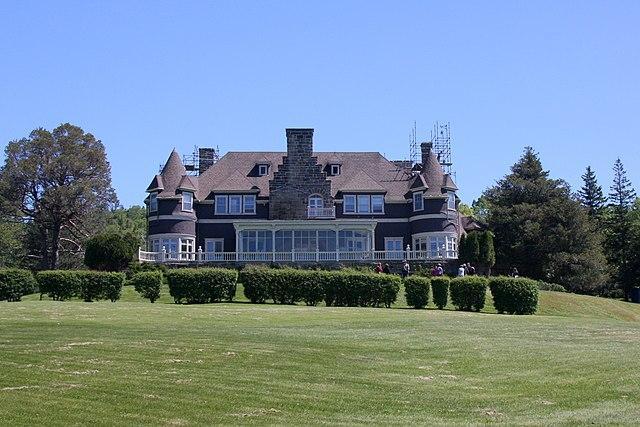Beinn Bhreagh is a historic estate that sits on a peninsula jutting into the Bras d’Or Lake on Cape Breton Island, in the Canadian province of Nova Scotia. The land, known to the Mi’kmaq as Megwatpatek, was purchased by Alexander Graham Bell and his wife, Mabel, in the late 1880s. The peninsula was renamed Beinn Bhreagh, which means “Beautiful Mountain” in Scottish Gaelic, and the estate grew to encompass approximately 242.8 hectares (600 acres) of land. The estate, which includes several buildings, including Beinn Bhreagh Hall, was used by the Bell family for both scientific research and personal residence.
The construction of Beinn Bhreagh Hall, which is also referred to as “The Point,” was completed in 1893. The family used it as their summer residence and laboratory. The house is an outstanding example of Shingle style architecture, which is common in New England. It features circular towers and stone fireplaces. Mabel designed the surrounding gardens, which frame the estate, where Alexander Graham Bell accomplished some of his greatest scientific research.
The Bells were attracted to Beinn Bhreagh’s landscape, climate, and Scottish traditions and culture, which reminded them of their birthplace in Edinburgh, Scotland. After falling in love with the area, they decided to purchase the end of the peninsula for their estate, which was previously owned by many different people. It was the purchase of the final piece of property that connected all Bell’s land together that inspired the building of Beinn Bhreagh Hall.
The Bells believed that providing “decent places for our work people” was more important than building a large house for themselves. They built several houses for their workers prior to the construction of Beinn Bhreagh Hall. In the early 1900s, the Bells were trying to make the estate more self-sufficient and established departments, each with a department head who would report to an estate manager. These departments included the Laboratory, the Nursery Department, the Farm Department, the Stable Department, and the Buildings and Wharves Department, and each had its own responsibilities for the estate.
The land continued to be farmed by employees, with beef and dairy cattle, pigs, chickens, vegetable gardens, fruit trees, and hay crops all being produced. The entire property was the site of various sorts of experiments, be they on land, or water, or in the sky. By 1907, the Bells had created and maintained twelve miles of roads stretching around, up, and down the mountainside.
The Bells’ experiments and scientific discoveries at Beinn Bhreagh covered a diverse range of subjects, including flight, water, vegetation, and sheep breeding. They established the Aerial Experiment Association, which developed early aircraft, including the Silver Dart, flown in 1909 over Bras d’Or Lake in Canada’s first controlled, powered flight. Bell also conducted experiments in powered flight and hydrofoil technology, among many other things.
The Beinn Bhreagh estate was a hub for scientific discourse, with important people from science and government coming as guests of the family. While there, they engaged in lively and thoughtful discussions. The estate was also a place where social development transformed the community and beyond, led primarily by Mabel, initiating the first Montessori school, the concept of equal pay for women, and good working conditions for all.
The gardens at Beinn Bhreagh became one of the Bells’ most successful endeavors, supplying fresh produce to feed the family, friends, and employees, with additional revenue from the sale of surplus. Mabel was the architect behind most of the garden development, including flowers, vegetables, and fruit orchards.
Visitors to the Alexander Graham Bell National Historic Site can explore the history of Beinn Bhreagh and learn about Bell’s many scientific and technological contributions. The museum houses exhibits about Bell’s life and work, including replicas of his inventions and historic photographs and documents.
The Beinn Bhreagh estate and the Bell family’s legacy continue to have a significant impact on the local community and beyond. In addition to inspiring future generations of scientists and inventors, the family’s philanthropic efforts have supported many important causes. Mabel Bell was a passionate advocate for the education and empowerment of women, and her work helped to lay the foundation for women’s rights in Canada.
Today, the Beinn Bhreagh estate remains a private family property, and is not open to the public. However, visitors can still catch a glimpse of the historic property from the water, as they explore Bras d’Or Lake and the surrounding area. And although the estate itself may not be accessible, the legacy of Alexander Graham Bell and his family lives on through their many contributions to science, technology, and society.
References:










